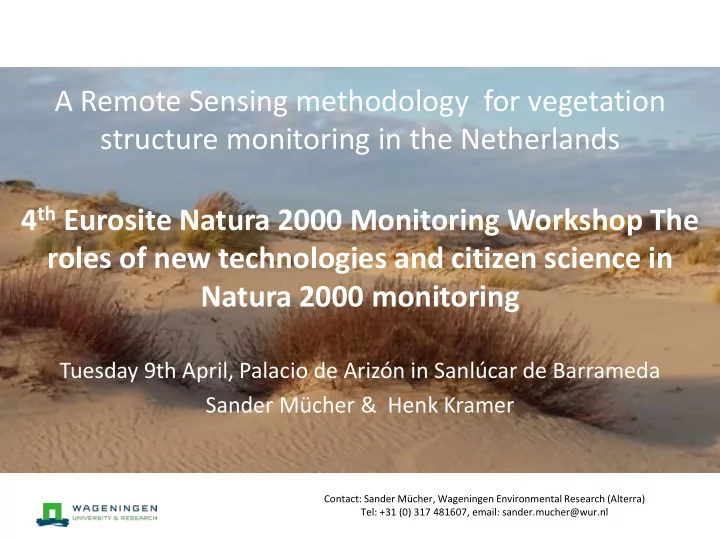

A Remote Sensing methodology for vegetation structure monitoring in the Netherlands 4 th Eurosite Natura 2000 Monitoring Workshop The roles of new technologies and citizen science in Natura 2000 monitoring Tuesday 9th April, Palacio de Arizón in Sanlúcar de Barrameda Sander Mücher & Henk Kramer Contact: Sander Mücher, Wageningen Environmental Research (Alterra) Tel: +31 (0) 317 481607, email: sander.mucher@wur.nl
Background • Conventional vegetation mapping & monitoring in the Netherlands is labour intensive and therefore costly. • Moreover there is subjectivity in the interpretations making change detection not always easy • Due to new policy demands (e.g. PAS) there is a need for more frequent updates. • Therefore also in the Netherlands there is now need for alternative methods that enable more frequent updates
Objective Sources of imagery (spaceborn and airborne) have nowadays a sufficient high resolution, 1 meter or less, that can support especially the mapping and monitoring of vegetation structure types in the Netherlands at scale 1:10.000. � Objective : finding best Remote Sensing method for vegetation structure monitoring in the Netherlands
Content • Mapping habitats and vegetation structure types • Monitoring habitats and vegetation structure types • Hot spot monitoring using drones • Conclusions
Habitat Mapping BIO-SOS, EODHaM: A key component of the system is the inclusion of decision rules within a hierarchical classification structure with these generated from expert knowledge from both ecologists and remote sensing scientists.
Dutch Challenge: using commonly shared data aerial photographs and LiDAR data for mapping vegetation structure in the Netherlands
DATA: Dutch Aerial photographs • 25 cm pixel resolution • RGB + NIR • Every year spring and summer coverage • Commonly shared (but not completely open source) 7
DATA: LiDAR point cloud data • LiDAR Data (AHN = height model of the Netherlands) • 15 points/m 2 -> DEM with 50 cm resolution • coverage for NL every 6 years • Open source 8
Method: Object based classification with eCognition: Rule-based versus Machine learning (Random Forest) 9
Classification results Vegetation Structure Types Rule based classification (RB) Accuracy 84.1 % Random Forest classification (RF) Accuracy 86.4 % 10 Mücher, et al., 2019. Journal of Earth Sciences & Environmental Studies, VOLUME: 4 ISSUE: 1, pp 502-505. DOI: 10.25177/JESES.4.1.2
Result Rule based versus Random Forest • Aerial photographs in combination with LiDAR data suited as input for vegetation structure mapping • RB and RF comparable good classification results, resp. 84.1 % and 86.4 % • RF requires high demand on quality of georeferenced training data, iterative process of removing bad training points or add additional training points. • Slight preference for machine learning if training data can be provided.
RS Vegetation Change Detection Methodology Selection Natura 2000 site & use existing habitat map LiDAR (AHN-2) LiDAR (AHN-3) VHRS T1 VHRS T2 ~2008 ~ 2014 22-06-2009 27-08-2014 Changes Changes in Land Vegetation Height Cover (cm) Translate from pixel into object information e.g. shrub encroachment coastal grey dunes (H2130) Mücher et al., 2017. Ontwikkelen Remote Sensing monitoringssystematiek voor vegetatiestructuur. Pilot studie: detectie verruiging Grijze Duinen (H2130) voor het Natura 2000-gebied Meijendel- Berkheide. Wageningen, Wageningen Environmental Research, Rapport 2838, 46 pp.
Vegetation monitoring Dunes Scale 1:5000 GeoEye-1 22 June 2009 GeoEye-1 22 June 2009 Veg cover types 2009 Vegetation height 2009 Veg cover types 2009 Vegetation height 2009 WV-2 27 August 2014 WV-2 27 August 2014 Veg cover types 2014 Vegetation height 2014 Veg cover types 2014
Vegetation monitoring Dunes Scale 1:5000 GeoEye-1 22 June 2009 Veg cover types 2009 Vegetation height 2009 WV-2 27 August 2014 Veg cover types 2014 Vegetation height 2014
Vegetation monitoring Dunes Scale 1:5000 GeoEye-1 22 June 2009 Veg cover types 2009 Vegetation height 2009 WV-2 27 August 2014 Veg cover types 2014 Vegetation height 2014
Paaltjes van afrastering zichtbaar in hoogtebestand
H2130 Grey Dunes (blue lines) with percentage shrub and tree encroachment
Hotspot monitoring LiDAR RiCopter 350.000 measurements/sec Scan ~ 100 ha per day
Hotspot monitoring with LiDAR RiCopter
Hotspot monitoring with LiDAR RiCopter
AHN3 (2014) Crataegus monogyna RiCopter (2017) Crataegus monogyna
AHN3 in wit, RiCopter als RGB LiDAR RiCopter Dense point cloud data Very low vegetation Dune Grasslands AHN3 liDAR sparse point cloud data
Conclusions • Combined LiDAR & NIR aerial photographs suitable for mapping vegetation structure types at very detailed scale. • Random Forest and Decision tree classification comparable results. • Machine learning easier but requires a lot of training data (annotation) • Machine learning we exploit for individual plant and animal species detection using (sub)centimeter drone imagery.
Conclusions • Vegetation structure monitoring can be made operational for Netherlands based on 6 yearly national coverage LiDAR data, combined with VHRS. • But agreement needed on e.g. height classes by all site managers ! • If updates are needed more frequently, hot spot monitoring with drones • In the Netherlands potential of RS products just starting for nature monitoring due to required detail • Exploit RS products more for veg monitoring than veg mapping ?!
Thank you for your attention !
Recommend
More recommend